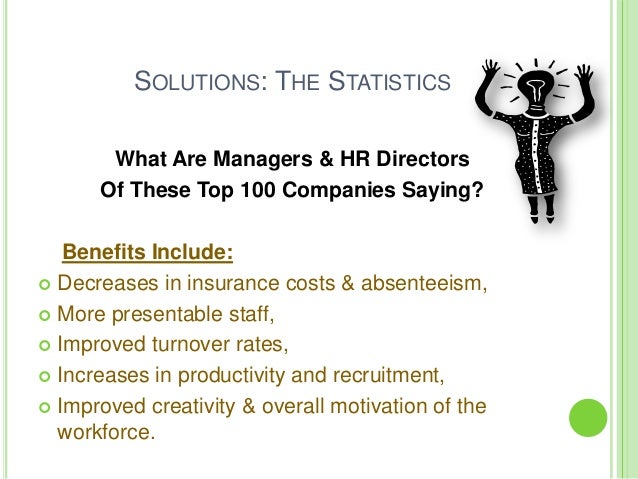Workplace Wellness Programs Statistics Definition
The.gov means it’s official. Federal government websites often end in.gov or.mil. Before sharing sensitive information, make sure you're on a federal government site. How well a financial wellness program is designed can determine whether it succeeds in reducing employees’ money-related stress, which can affect worker productivity and engagement.
Wellness should be tailored and made relevant to your employees—not the other way around.Many companies choose to offer preventative services like biometric screenings and health fairs. Others focus on health education. Still others choose specific issues to focus on like smoking cessation or physical activity. All are excellent options in building a wellness program relevant to the needs of your workforce.
They’re Surprisingly Easy
There are a variety of resources available to make wellness a surprisingly easy task to manage. In fact, many companies don’t even have one specific position designated to managing their wellness program. That’s because wellness programs can easily be managed by committee, or even lumped with similar HR duties.

Your wellness program doesn’t have to cause extra stress—that would actually defeat the purpose and counteract your focus on health. With the vast amount of credible health information online, and the emergence of companies dedicated to employee health, wellness programs are easier to manage than ever before.
They Can Be Highly Inclusive


Some people worry that wellness programs only reward people who are already healthy, and wind up punishing those who still have a ways to go. The truth is, however, that wellness can be incredibly inclusive. As research continues to support the importance of a holistically healthy lifestyle, wellness programs have expanded to address health on multiple levels.
Many wellness programs now address things like emotional well-being, mental health and financial wellness. They can also include all types of people. All programs address the health of their employees. Many have extended into the home to also impact the health of spouses and dependents.
They Go Hand in Hand With The Tech Trend
Technology is ever-changing. New trends hit the market every day. Employee wellness programs have worked hard to keep up. Many programs have integrated with online platforms to allow employees access to health information at all times.
Other programs utilize common technology tools to help collect and track wellness data. A popular trend is to make wellness work with wearables. As employees track their activity with devices like Fitbit or the Apple Watch, they can earn points for the progress they make and achieve the incentives their programs offer.
They Can Adapt To Corporate Culture
Like I said, every company does wellness differently, and that’s the way it should be. Wellness is incredibly adaptable because health means something different in different contexts. It’s important to take evidence-based health information and integrate it with your specific company culture.
That means working with your employees to learn what they value on the journey toward better health. It also means finding wellness activities your employees want to be a part of and addressing issues that are actually a challenge at your company.
They’re Incredibly Popular
A vast majority of companies address employee wellness in some way. In fact, the Society for Human Resource Management reported that, in 2015, 80% of employers offered preventative wellness services and information. The popularity increases with larger workforces. Some reports suggest up to 92% of employers with over 200 employees offer a wellness program.
They’re Paying Off
The popularity is well-deserved. Employee wellness programs are successful in a lot of different ways. For companies, wellness programs have been shown to boast an average return on investment (ROI) of about 3:1. Outside of the direct financial gains, companies have seen reductions in employee absenteeism, staff turnover and employee stress.
For employees, wellness programs have been associated with a whole host of health benefits. These programs can lead to a greater readiness to change exercise behaviors, increased fruit and vegetable intake, decreases in body weight, increased adoption of smoking cessation and improved mental health. For all parties involved, wellness programs are working.
They’re Made For Employees
Corporate Wellness Program Statistics
It’s not all about the corporate ROI, though! It’s about the value added to your company and your human capital. Many companies get caught up in the financial benefit and savings an employee wellness program can provide, but that’s not what matters most.
Wellness programs are built for employees. They’re designed to help employees learn about and make healthy lifestyle choices. Ultimately, your employees should be the focus of your wellness program—end of story.
Wellness programs can and should differ from company to company. The important thing is that you and your leadership team are thinking about and discussing the importance of the health of your employee population.